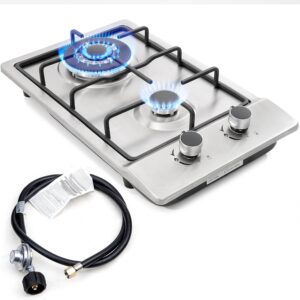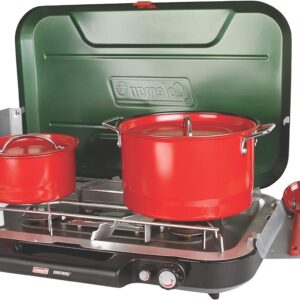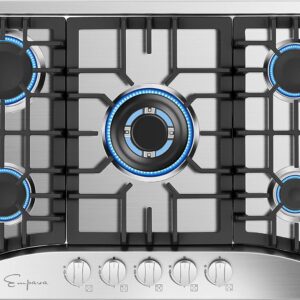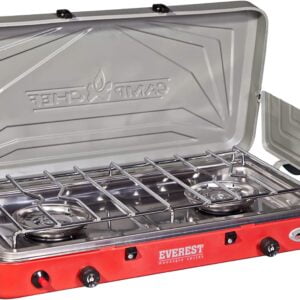Department
Stoves
Propane Stoves
- Propane Gas Stoves
- Single Burner
- 2 Burner
- 3 Burner
- Propane Kitchen Stoves
- Heavy Duty Propane Burners
- Heavy Duty Single Burner
- Heavy Duty Double Burner
Burners
Cooktops
Gas Stoves
Showing all 9 resultsSorted by popularity
-

Forimo 12-Inch Stainless Steel Gas Cooktop with 2 Burners, Drop-in Propane/Natural Gas Cooker, Dual Fuel 12″ Gas Stove Top for Easy Cleaning (12″W x 20″L)
$99.99 -

Forimo Portable Propane Gas Cooktop, Single Burner Stove with Auto Ignition, Tempered Glass, Ideal for Camping, RVs, Apartments, and Outdoor Cooking
$55.99 -

Koblenz Victoria 4-Burner Gas Stove, Bronze, 16,000 BTUs, 18″ x 24
$64.90 -
Sale!

Coleman Classic Portable 3-Burner Propane Camping Stove, Instant Ignition, Wind Guards, Pressure Control, Carry Handle – 28,000 BTUs
Original price was: $179.99.$158.00Current price is: $158.00. -
Sale!

Empava 30-Inch Stainless Steel Gas Stove Cooktop: 5 Italy Sabaf Sealed Burners, Convertible NG/LPG, Silver Finish
Original price was: $377.77.$359.00Current price is: $359.00. -
Sale!

Camp Chef Everest 2 Burner Portable Stove
Original price was: $169.99.$159.99Current price is: $159.99. -
Sale!

Gas One GS-3400P Portable Dual Fuel Stove – Propane and Butane Compatible – Camping Grill/Stove with Carrying Case, Adjustable Burners, and Wind Guards
Original price was: $32.99.$30.69Current price is: $30.69. -

Coleman Triton+ 2-Burner Propane Camping Stove, Portable Grill/Stove with Adjustable Burners, Instant Push-Button Ignition, Wind Guards, and a Total of 22,000 BTUs of Cooking Power
$109.99 -
Sale!

Tabletop 2-in-1 Camping Grill/Stove: Dual-Purpose 2-Burner Propane Grill and Stove for Outdoor Cooking, Delivering 20,000 BTUs of Heat
Original price was: $134.99.$109.74Current price is: $109.74.
Usage and precautions of gas stoves
Gas stoves have been a popular choice for cooking in homes worldwide for their convenience, efficiency, and precise temperature control. Whether you’re a beginner or an experienced cook, this comprehensive guide will provide you with essential information and tips to make the most out of your gas stove.
Read the Manufacturer’s Instructions:
- Before using a new gas stove, carefully read and understand the manufacturer’s instructions and safety guidelines. Follow them strictly to ensure safe operation.
1.1 Components of a Gas Stove:
- Burners: These are the individual heating elements where you place your cookware.
- Control Knobs: Used to adjust the flame size and temperature.
- Ignition: Modern gas stoves typically have electronic ignition systems, eliminating the need for matches.
- Oven (optional): Some gas stoves come with an oven for baking and roasting.
1.2 Safety Precautions:
- Ensure proper ventilation in your kitchen to prevent the buildup of gas fumes.
- Keep flammable objects away from the stove while cooking.
- Regularly check gas connections for leaks.
- Install and maintain a carbon monoxide detector in your kitchen.
- Operating a Gas Stove:
2.1 Lighting the Gas Stove:
- Turn off all burner knobs before lighting.
- Place a lit match or lighter near the burner.
- Turn the corresponding burner knob to the “Light” or “Ignite” position.
- Once the burner lights, adjust the flame to the desired size.
2.2 Adjusting Flame Size:
- Turn the burner knob counterclockwise to increase the flame size.
- Turn the burner knob clockwise to decrease the flame size.
- Adjust the flame according to the cooking requirements (e.g., high heat for boiling and low heat for simmering).
2.3 Understanding Burner Controls:
- Some gas stoves have different burner sizes (large and small) or special features like a wok burner.
- Familiarize yourself with the control layout and markings for each burner.
- Follow the manufacturer’s instructions for using specific burners effectively.
2.4 Turning off the Gas Stove:
- Turn all burner knobs to the “Off” position.
- Verify that the flames have been extinguished.
- If you suspect a gas leak, turn off the main gas supply and contact a professional immediately.
- Maintenance and Cleaning:
3.1 Cleaning Gas Stove Burners:
- Remove the burners from the stove.
- Soak them in warm, soapy water for a few minutes.
- Scrub away any residue or grime using a soft brush or sponge.
- Rinse the burners thoroughly and let them dry before reassembling.
3.2 Cleaning Gas Stove Grates:
- Remove the grates from the stove.
- Scrub them with a mixture of baking soda and water or a mild detergent.
- Rinse and dry the grates before placing them back on the stove.
3.3 Cleaning the Stove Surface:
- Wipe down the stove surface with a damp cloth or sponge after each use.
- For stubborn stains or spills, use a non-abrasive cleaner recommended by the stove manufacturer.
- Avoid using harsh chemicals that can damage the stove’s surface.
3.4 Cleaning the Oven (if applicable):
- Refer to the oven’s user manual for specific cleaning instructions.
- Regularly wipe down the interior with a damp cloth or sponge.
- Use an oven cleaner for stubborn stains or follow a self-cleaning cycle, if available.
- Troubleshooting Common Issues:
4.1 Weak or Uneven Flame:
- Check for clogged burner holes and clean them with a pin or needle.
- Verify that the burner cap is correctly aligned and placed.
- If the issue persists, contact a professional technician.
4.2 Gas Odor:
- If you smell gas, open windows, and doors to ventilate the area.
- Do not use any ignition sources or electrical switches.
- Shut off the gas supply and contact your gas company or a professional immediately.
4.3 Ignition Problems:
- Ensure the stove is plugged in or the gas supply is turned on.
- Clean the igniter and check for any loose connections.
- Replace the igniter if necessary or contact a professional technician.
4.4 Pilot Light Issues:
- Follow the manufacturer’s instructions to relight the pilot light.
- If the pilot light keeps going out or has a weak flame, contact a professional technician.
- Cooking Tips for Gas Stoves:
5.1 Using the Right Cookware:
- Choose cookware with flat and thick bottoms for even heat distribution.
- Opt for materials like stainless steel, cast iron, or copper for better heat retention.
5.2 Adjusting Flame for Different Cooking Techniques:
- High heat for boiling, searing, and stir-frying.
- Medium heat for sautéing and frying.
- Low heat for simmering, melting, and delicate sauces.
5.3 Cooking on Multiple Burners:
- Arrange cookware on the burners to maximize space and avoid overcrowding.
- Adjust flame sizes individually to ensure proper heat distribution.
5.4 Preheating the Oven:
- Preheat the oven to the desired temperature before baking or roasting.
- Allow sufficient time for the oven to reach the desired temperature.
- Energy Efficiency and Safety:
6.1 Energy-Saving Tips:
- Use the right-sized burner for your cookware to avoid heat loss.
- Keep burner surfaces and reflectors clean for efficient heat transfer.
- Match the pot size to the burner size to minimize heat loss.
6.2 Carbon Monoxide Safety:
- Install a carbon monoxide detector in your kitchen.
- Ensure proper ventilation and airflow to avoid the buildup of carbon monoxide.
6.3 Gas Leak Detection:
- Regularly check gas connections for leaks using a solution of soapy water.
- If bubbles form when applied to a connection, there is a gas leak. Contact a professional technician.







